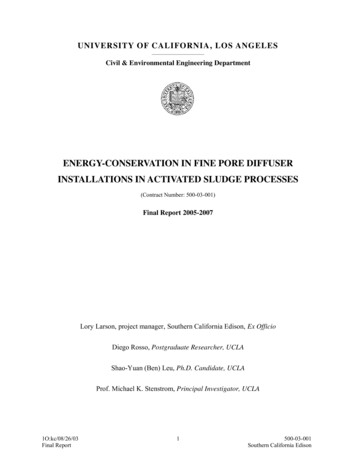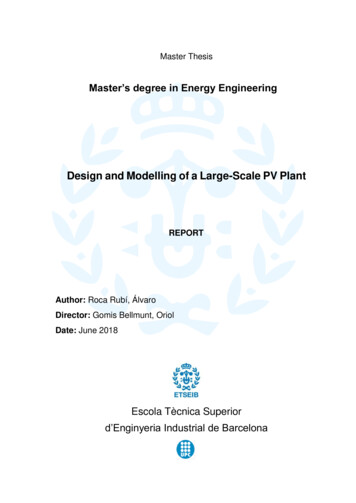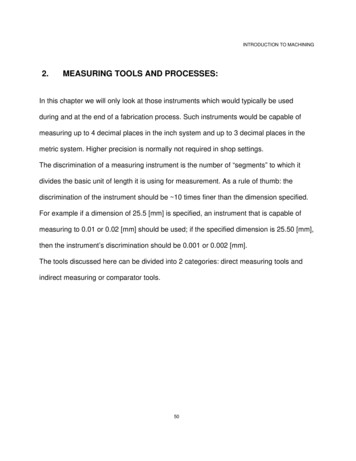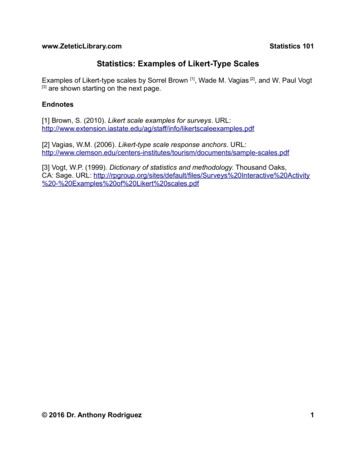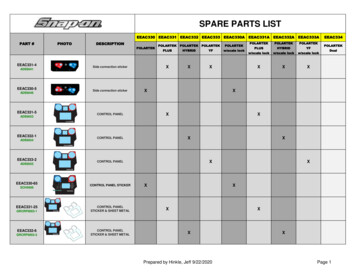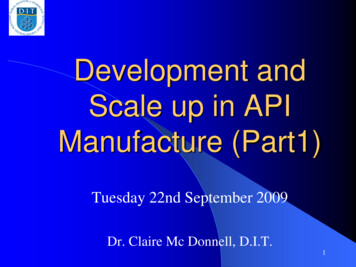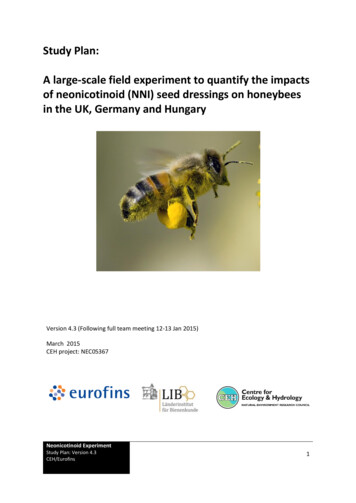
Transcription
Study Plan:A large-scale field experiment to quantify the impactsof neonicotinoid (NNI) seed dressings on honeybeesin the UK, Germany and HungaryVersion 4.3 (Following full team meeting 12-13 Jan 2015)March 2015CEH project: NEC05367Neonicotinoid ExperimentStudy Plan: Version 4.3CEH/Eurofins1
1Contact detailsNeonicotinoid ExperimentStudy Plan: Version 4.3CEH/Eurofins2
Neonicotinoid ExperimentStudy Plan: Version 4.3CEH/Eurofins3
Contents1Contact details . 22Study Objective . 63Experimental Design . 63.1Definition of terms used in the experimental design . 63.2Treatments . 63.3Spatial separation . 73.4Crop agronomy . 93.5Measurements. 104Materials & Methods . 114.1Test Item and Control . 114.2Drilling and crop maintenance details . 154.3Test Organism . 164.3.14.4Attributes of the test honeybee colonies . 16Description of the Test Method . 174.4.1Test Location . 174.4.2Design and Lay-out of the Test . 195Assessment Methods . 295.1Condition of the colony and brood development . 295.2Forager mortality assessment . 305.3Flight Activity and foraging behavior assessments . 315.4Survey of surrounding land cover and flowering resources. 355.5Disease analysis . 405.5.1Selections of pathogens to study . 405.5.2Sampling . 406Residue sampling . 426.1Residue sampling from caged bees . 436.2Nectar and pollen sampling from free-flying bees . 446.2.1Nectar sampling . 446.2.2Pollen sampling . 466.3Residue sampling from stored hive products . 476.3.1Honey and pollen . 47Neonicotinoid ExperimentStudy Plan: Version 4.3CEH/Eurofins4
6.3.2Wax . 486.4Residue sampling from oilseed rape flowers and leaf material . 496.5Residue Analysis . 507Other measurements . 517.1Recording of the meteorological data . 517.2Photographical documentation . 518Data management . 528.1Data sets . 529Timing of project activities. 5510Archiving . 5611Distribution . 5711.1Study Plan . 5711.2Raw Data. 5712Responsibilities . 5812.1Responsibility. 5812.2Deviations from and Amendments to the Study Plan and SOP s . 5812.3Confidentiality . 5913References . 60Neonicotinoid ExperimentStudy Plan: Version 4.3CEH/Eurofins5
2Study ObjectiveThe aim of the study is to quantify whether there is an impact on honeybees of two neonicotinoids(NNI) seed treatments applied to commercially grown oilseed rape (OSR) crops (‘Clothianidin’ BayerCropScience and ‘Thiamethoxam’ Syngenta). Specifically we will test the null hypothesis that thereis no impact of neonicotinoid seed treatments on population growth, mortality or overwinteringsurvival of honeybees foraging on oilseed rape treated with this pesticide. Note, that thisrepresents a null hypothesis only and that we make no a priori assumption of the impact of thispesticide on honeybees.3Experimental DesignIn order to achieve the study aim a large-scale field experiment has been established on commercialfarms in the United Kingdom, Germany and Hungary in autumn 2014 for monitoring and harvestingin 2015. This will take full advantage of the European moratorium on NNI use by improving thechances of NNI-free control treatments. A schematic representation of the experimental design isgiven in Figures 1 & 2 below. Note we include a glossary in the appendix of this document thatdefines specific terms relating to the experimental design (Appendix 1).3.1Definition of terms used in the experimental designAppendix 1 includes definitions of terms used in this study. However, for clarity the following keyterms are described here: Site (36 in total) a field or group of adjacent fields where a single treatment is appliedTreatment (3 in total) the experimental intervention applied to a site :(a) control or (b)Clothianidin or (c) ThiamethoxamUnit of replication (11 in total) block of each of three treatments (UK 4; Germany 3;Hungary 4)See Figure 1 below.3.2TreatmentsOn each site a large area ranging in size from 45-70ha (depending on field size) was sown withoilseed rape in the summer of 2014. Each site was allocated to one of three experimental treatmentsat random, namely:a. without Neonicotinoid seed treatment (CONTROL);b. Clothianidin ( Bayer Crop Science Modesto Tm or Elado Tm) seed treatment; andc. Thiamethoxam (Syngenta Cruiser OSR tm) seed treatment.Neonicotinoid ExperimentStudy Plan: Version 4.3CEH/Eurofins6
In Hungary there are four replicates of the three treatments (12 sites), in Germany there are threereplicates (due to the constraints of the experimental licence; 9 sites) and in the UK there are fourreplicates of the three treatments. In the UK there will also be an additional three untreatedcontrol sites as residual but detectable levels of neonicotinoids were identified within some of thesoils of the original control sites. Ultimately exposure of bees to neonicotinoids will be quantifieddirectly in 2015 by chemical detection of the active ingredients within pollen and nectar of theoilseed rape crops. The three additional control sites are intended to reduce this potential risk byproviding reserve sites should neonicotinoids be expressed in the oilseed rape crops of the controlsites. This will give a total of 12 3 15 sites for the UK. The supplementary control sites used inthe UK will only be considered if neonicotinoids are expressed in the oilseed rape crop (pollen andnectar) of the original control sites.3.3Spatial separationEach replicate of the three treatments (a, b, c) has been chosen to be in the same general landscapeand on the same soil type. Each replicate is separated by at least 10km and each site within areplicate block is separated from its neighbour by a minimum of 3.2 km. This was intended tominimize the possibility of bees from different sites within a block foraging on oilseed rapeestablished as part of the treatments applied to another site within that same block. Note, with theexception of sites B6 and B12 of theblock in Hungary all other replicate blocks have sitesseparated by at least 4 km. Within each of the 36 sites the area of treated crop (defined below) willbe sufficiently large to ensure foraging honeybees receive a high although realistic exposure to thepesticide, i.e. there will be fewer opportunities to forage on neighboring habitats and possiblyuntreated oilseed rape (a criticism of some previous field trials). Spatial data sets on land cover andproportion of major crops grown were used to ensure that variation in landscape structure betweencountries is minimized.Neonicotinoid ExperimentStudy Plan: Version 4.3CEH/Eurofins7
Figure 1. Schematic representation of the experimental design1) Country scale replicationUKGermanyHungary2) Replicate blocks within eachcountry4) Within site layoutHoneybee hiveNeonicotinoid honeybee exposure tents 10 kmseparationBehavioural transect walksCereal / crops not attractive to beesin spring3) Within block treatments (allocatedOSROSROSROSRto separate sites)Control: noNeonicotinoids 3 kmseparationTreatment 1:Treatment 2:ClothianidinThiamethoxamSown OSR c.50 ha per site(single field or group)Neonicotinoid ExperimentStudy Plan: Version 4.3CEH/Eurofins8
Figure 2. An example of a typical siteSurrounding landscape dominatedby cereal/crops not attractive tobees in spring3.2 km to next treatmentsite3.4Crop agronomyThe treated and untreated oilseed rape is the same hybrid variety in each country: UK (var. Harper Bayer); Germany (var. Flyer - Bayer); and Hungary (var. Hybrirock - KWS). The selected varieties werechosen to reflect widely grown varieties for a given country and will be established and grownaccording to Good Agricultural Practice.A simple verification of crop plant density will be undertaken at each site in the spring of 2015. Thiswill be achieved by counting and recording plant density per square meter at 20 random locationsacross each site in representative areas of the crop (i.e. avoiding tramlines or other areas of poorcrop establishment). Notes will be made on evidence of damage together with photographs. Thesecounts will be made during a routine site visit in spring 2015. These assessments are intended toprovide an overview of the crop state in the immediate proximity of the hives. Given the sometimesvery large size of fields it will not be possible to accurately assess crop damage over the whole ofthese fields.It is critically important that measures to control pollen beetle infestation at yellow bud and earlyflower stage do not harm bees and in so doing mask any NNI effects. Therefore measures to controlpollen beetle in spring 2015 will be coordinated so as to be consistent in timing across blocks(replicates). Co-ordination of this will be undertaken by Eurofins in Hungary and Germany, and byWildlife Farming Co. in the UK. At the country level the choice of pesticide products applied to theNeonicotinoid ExperimentStudy Plan: Version 4.3CEH/Eurofins9
oilseed rape will be consistent (and compliant with local regulations on pesticide use). The chosenpesticide products will be selected to pose the minimum possible risk to bees. All application will beapplied in the fields of a block within three days.Proposed approach:1) UK sites: Position 1 do not spray for pollen beetle (the case for the last 4 years in the studyregion); Position 2 if threshold exceeded at yellow bud stage then all farmers in a replicateblock spray with Tau-fluvalinate (trade name Mavrik ADAMA; the most bee friendlyinsecticide allowed based on label toxicity). This is to be coordinated by the Wildlife Farmingco. All applications will be applied in the fields of a block within three days.2) German and Hungarian sites: spraying for pollen beetle or other pests will almost certainlybe necessary. In Hungary Maverick will be applied once before flowering if there isconsiderable pressure and once towards the end of flowering. For theBlock inGermany the pyrethroid Maverik will be applied before flowering, although it is expectedthat no pyrethroids will need to be applied during the flowering stage. For the remainingtwo German blocks either the B4 (no harm to bees) pyrethroid Karate (a.i. Lambdacyhalothrin), or the B2 (applied after bee flight until 23:00 h) pyrethroids Bulldock (a.i. betacyfluthrin) and Fury (a.i. zeta-cypermethrin) will be used. All application will be applied inthe fields of a block within three days. This will be coordinated by Eurofins.3) Organophosphate stem weevil treatments will be applied during BBCH55 bud stage (mid tolate March) in Hungary ( a.i. Chlorpyriphos) and in Germany (Avaunt (a.i. Indoxacarb) andTrebon (a.i. Etofenprox)). All application will be applied in the fields of a block within threedays. This will be coordinated by Eurofins.All agronomic inputs and timings will be recorded for each site, together with estimates of cropyield.3.5MeasurementsThe following measurements will be made to assess exposure and effects of NNIs on honeybees.These are summarized below with full detailed provided in the preceding text: Honeybee colony metrics, including size and weight (to the nearest 50 g), growth rate,foraging behavior, reproductive success, incidence of pathogens and parasites, andoverwinter survival;NNI residues expressed from the crop (nectar and pollen), in stored hive products (honey,pollen and wax), in the soil and plant tissue. Note, soil chemistry measures were taken priorto sowing of oilseed rape in 2014 to identify if control plots were established on fields withresidual levels of neonicotinoids. In each case 10 soil cores to a depth of 20 cm wereNeonicotinoid ExperimentStudy Plan: Version 4.3CEH/Eurofins10
collected along a transect (separated by 20 m) in individual fields. These cores werehomogenized and tested for Neonicotinoid residues.Other measures: composition of honeybee pollen loads to measure exposure to oilseed rapeand other flower resources;Agronomic measures: pesticide and fertiliser input, and yield of the crop. Note that we willcollect information on yield, although this will be used to identify if the crop is both fit andhealthy. Comparisons of both crop yield and quality in response to the seed treatments willbe confounded by management intended to ensure high exposure to neonicotinoids of thebees. For example, in the case in the control plots we aim to ensure good crop health inspite of the absence of the neonicotinoid seed treatment.Measurements will be taken of the honeybee colonies shortly before the set-up of the hives atthe fields (pre-exposure), at several points during crop flowering (the exposure phase), andbefore and after winter (post-exposure).4Materials & Methods4.1Test Item and ControlVerification of Sowing and pesticide application ratesSubsamples of the treated and untreated seed in each country will be sent for analysis at the testingfacilities at Bayer Crop Science and Syngenta respectively to accurately determine the product doserate applied. Samples of the treated and untreated seed will be retained by CEH for further analysisif required. Samples are to be sent to, Centre for Ecology & Hydrology, CrowmarshGifford, Wallingford OX10 8BB. UK. We require representative seed.The information about the test item and control are given in Tables 1-3 below.Neonicotinoid ExperimentStudy Plan: Version 4.3CEH/Eurofins11
Table 1.Details of the test item#1 - clothianidinOilseed rape (Brassica napus) seed treated withcommercial neonicotinoid (clothianidin) andfungicide seed treatmentElado tm / Modesto tm400 g/L (32.5% w/w) clothianidin and80 g/L (6.51% w/w) beta-cyfluthrinName of seed treatmentformulationTOX-NumberBatch-IDGAB-codeSeed variety1000-grain-weightActive ingredient(s)UK:Modesto @ 12.5 l/t Hypro Duet @ 9.0l/t Modesto 12.5 ml product /kg seed*Seed drilled @ 50 seeds/m2Germany:Elado (CTL): 25 ml product/kg seed*Seed drilled @ 50 seeds/m2Hungary:Elado (CTL): 25 ml product/kg seed*Seed drilled @ 50 seeds/m2*Maximum registered application rate forcountry##UK – var. HarperGermany – var. FlyerHungary – var. Hybrirock5.1 gClothianidinBeta-cyfluthrinCAS-No.Modesto contains 400 g/L clothianidin and 80g/L beta-cyfluthrin applied at 1.25 Litresproduct per 100 kg seedContent(s) of a.i. nominalContent(s) of a.i. analyzedDate of certificateExpiry dateAppearanceDensity [g/mL]StorageSafety symbol(s)Intended Use (Target(s))# will be given in final reportmg a.s./seed itemai/ha to be confirmed by Bayerai/kg to be confirmed by Bayer##dressed seednot applicable 2 ºC to 30 ºCnoneInsecticide-dressed seedNeonicotinoid ExperimentStudy Plan: Version 4.3CEH/Eurofins12
Table 2.Details of the test item#2 – thiamethoxamOilseed rape (Brassica napus) seed treated withcommercial neonicotinoid (thiamethoxam) andfungicide seed treatmentCruiser OSRtm280 g/litre thiamethoxam, 8 g/litre fludioxonil and32.3 g/litre metalaxyl-MName of seed treatmentformulationUK:Cruiser OSR @ 15.0 l/t 15ml product /kg seed*Seed drilled @ 50 seeds/m220.15 g / 1,000,000 seedsGermany:Cruiser OSR @ 15.0 l/t 15ml product /kg seed*Seed drilled @ 50 seeds/m221.22 g / 1,000,000 seedsHungary:Cruiser OSR @ 15.0 l/t 15ml product /kg seed*Seed drilled @ 50 seeds/m222.28 g/ 1,000,000 seeds*Maximum registered application rate for countryTOX-NumberBatch-IDGAB-codeSeed variety##UK – var. HarperGermany – var. FlyerHungary – var. HybrirockUK – var. Harper:5.1 g1000-grain-weightGermany – var. Flyer:4.8 gActive ingredient(s)CAS-No.Content(s) of a.i. nominalHungary – var. Hybrirock:5.5 gThiamethoxamFludioxonilMetalaxyl-MCruiser contains 280 g / l TMXUK – var. Harper:3.95 g TMX / Kg seedContent(s) of a.i. analysedGermany – var. Flyer:4.42 g TMX / Kg seedNeonicotinoid ExperimentStudy Plan: Version 4.3CEH/Eurofins13
Date of certificateExpiry dateAppearanceDensity [g/mL]StorageSafety symbol(s)Intended Use (Target(s))Hungary – var. Hybrirock:4.05 g TMX / Kg seed##dressed seednot applicable 2 ºC to 30 ºCnoneInsecticide-dressed seed# will be given in final reportNeonicotinoid ExperimentStudy Plan: Version 4.3CEH/Eurofins14
Table 3. Details of the untreated controlName of seed treatmentformulationBatch-IDGAB-codeSeed variety1000-grain-weightActive ingredientAppearanceStorageSafety symbol(s)# will be given in final reportOilseed rape (Brassica napus) seed treated withcommercial fungicide seed treatmentUK:Control without insecticide; Hypro Duet only @9.0 l/t Seed drilled @ 50 seeds/m2Germany:Control: without insecticide; only TMTDFungicide (a.i. Thiram) 700 5,71 ml/kg DMM(a.i. Dimethomorph )10 g/kgSeed drilled @ 50 seeds/m2Hungary:Control: without insecticide; only TMTDFungicide (a.i. Thiram) 700 5,71 ml/kg DMM(a.i. Dimethomorph )10 g/kgSeed drilled @ 50 seeds/m2##UK – var. HarperGermany – var. FlyerHungary – var. HybrirockTo be confirmed by Bayer & SyngentaFungicide ai be confirmed by Bayer & Syngentanative seed 2 ºC to 30 ºCnoneFurther details of the treated and untreated seed will be summarized in the final report.4.2Drilling and crop maintenance detailsThe oilseed rape treated with neonicotinoid seed dressing and the untreated (control) was sown ineach country between July and August of 2014. In each replicate the treated sites were matchedwith a similar sized untreated control sites. In both cases, sown areas ranged from ca.45-70hadepending on field size. Treatment and control are separated by a minimum of 3.2 km in order tominimise the chance of the bees from one treatment visiting the field plot of the other treatment.The target seeding rate for all three oilseed rape varieties (treated and untreated) is 50 seeds m-2reflecting currently product labeling practice for maximum application rate. The seed used in thecontrol sites were of the same batch and variety as the seed used in the test item treated sites. Thecontrol seed was treated with the same fungicide as the test seed (Table 3). Equipment used fordrilling treated seeds was calibrated prior to use to ensure accurate application of seed. Details onNeonicotinoid ExperimentStudy Plan: Version 4.3CEH/Eurofins15
the type of equipment used, including sowing date and the actual seeding rate will be documentedin the raw data and given in the final report. As this is a non-GLP study drilling equipment wascalibrated according to good agronomic practice only.Each crop will be grown according to Good Agricultural Practice (GAP) guidelines and the timing andnature of management interventions will be recorded. The pesticide use history of all field sitesselected for this study will be documented for at least the two previous cropping seasons before thestart of the study.Use of any pesticide products containing neonicotinoids (e.g. Biscaya (Thiacloprid); InSyst(Acetamiprid)) as maintenance treatments is forbidden. Choice of products to be used formaintenance treatments will be discussed and agreed with the Study Director (in consultation withthe project team) prior to use. Pollen beetle control measures in spring 2015 will be coordinatedwithin each country to ensure (as far as possible) consistent timing and use of pesticide products inorder to minimize negative impacts on honeybees whilst ensuring good pest control. This will becoordinated in the UK by Wildlife Farming Co. and in Hungary and Germany by Eurofins.It is critically important that measures to control pollen beetle infestation at yellow bud and earlyflower stage do not harm bees and in so doing mask any NNI effects. Therefore measures tocontrol pollen beetle in spring 2015 will be coordinated so as to be consistent in timing andcomposition across blocks (replicates) (see Section 3.4). In all countries pesticide products andtiming of application will be selected to pose the minimum possible risk to bees. It is accepted thatthe timing of applications will be selected by the land owning farmers and the coordination role is toreduce variation as much as possible while documenting differences. This will be coordinated in theUK by Wildlife Farming Co. and in Hungary and Germany by Eurofins.4.3Test OrganismThe test organism for this experiment is the honeybee, Apis mellifera L. (Hymenoptera,Apidae).4.3.1 Attributes of the test honeybee coloniesBee colonies will be free of any clinical signs of disease and of a consistently high quality with thefollowing attributes at the start of exposure: Young queen / colony (1-2 years old);Colonies will be as similar to one another as possible (based on e.g. number of workerbees, age-structure and extent of brood);Minimum number of worker bees per colony will be approximately 4000;Pending an assessment of colony size in spring, hives to be distributed randomly (or as astratified random distribution) within blocks based on size-class distribution among eachcountry-scale sample. Option to cull from very large colonies is not desirable. Back-uphives will be available to optimize size-class distributions used (see Table 3). The biggestNeonicotinoid ExperimentStudy Plan: Version 4.3CEH/Eurofins16
4.4and smallest of the honey bee hives at a site (out of 8) will be allocated to be either theback-up hive or the hive used in the tent experiment (see section 6.1).Race: UK Buckfast; Germany, Hungary Carnica;Hives with two boxes (lower box brood chamber 1; upper box honeycomb box 2)including 10 combs each, although this number will depend on hive design (e.g. in theUK 11 combs are present in each hive);Additional bodies can be added to the top of the hive as the colony develops;Facility for separation of a bee hive in a brood chamber and in a honeycomb box with aqueen excluder. This is part of good apicultural practice and is conducted by most beekeepers to obtain honeycombs which have never been incubated.Description of the Test Method4.4.1 Test LocationMaps showing the exact location of all 36 study sites in Germany (9), Hungary (12) and the UK (15),and the random allocation of treatments have been provided by CEH. The sites are summarized trolNeonicotinoid ExperimentStudy Plan: Version 4.3CEH/Eurofins17
amAdditional hianidinThiamethoxamAdditional control*ControlClothianidinThiamethoxamAdditional control*Neonicotinoid ExperimentStudy Plan: Version 4.3CEH/Eurofins18
4.4.2Design and Lay-out of the TestThe field study will be carried out with the treatments and numbers of colonies given in Table 4.Treatment groupReplicatesControl (C)Clothianidin (T1)Thiamethoxam (T2)GRAND TOTAL11 3additionalcontrol sites inthe UK 141111No. of hivesfor exposurestudy per siteNo. of hives for Reservecrop residuehivessamplingTotal hives6111126611118888288Table 4. Treatment design showing number of hives4.4.2.1 Hive identifier numberEach honeybee hive will have a unique number (8 hives 36 sites 288 unique numbers). Theunique number will be attached to the base of each hive in a visible place. This unique number willbe noted (together with the unique site number) on the recording form for subsequent datacollection relating to the hives.Site codes for hives will conform to the following system (described in detail in Table 5).Country code (1 letter)This is a unique letter for each countryU UKH HungaryG GermanySite identification number (2 digits)This is a unique two digit code for each of the 36 individual fields. This will always be a two digitnumber, i.e. ‘02’ not ‘2’. Individual site identification numbers are continuous and so not replicatedin each country (i.e. there will not be a site 02 in Hungary and a field 02 in Germany, rather site willhave a unique number)For Germany these will be 01, 02, 03, 04, 05, 06, 07, 08, 09Hungary: 10, 11 . 21UK: 22, 23.36Neonicotinoid ExperimentStudy Plan: Version 4.3CEH/Eurofins19
Individual hive code (‘H’ and 3 digits)Hive code numbers will always be prefixed by ‘H’. This number is a unique three digit code for eachof the hives. This will always be a three digit number, i.e. ‘H002’ not ‘H2’. Individual hiveidentification numbers are continuous and so not replicated in each country (i.e. there will not be aH002 hive in Hungary and a field 002 in Germany, rather site will have a unique number)For the Germany Blumberg blockH067, H068, H069, H070, H071, H072field the hive numbers will be H065, H066,Example unique code descriptors will be: G01-H065, H10-H081 and 15115916712708808010413615216016812811122233Field name059003011019035027043Block ID05800201001
Study Plan: Version 4.3 6 CEH/Eurofins 2 Study Objective The aim of the study is to quantify whether there is an impact on honeybees of two neonicotinoids (NNI) seed treatments applied to commercially grown oilseed rape (OSR) crops (‘Clot

